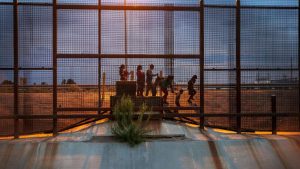AUGUST 21, 2019
 Brothers, ages 4 and 3, from El Salvador at a Border Patrol station in Brownsville, Tex., in 2014. Todd Heisler/NY Times
Brothers, ages 4 and 3, from El Salvador at a Border Patrol station in Brownsville, Tex., in 2014. Todd Heisler/NY Times
LOS ANGELES, CALIFORNIA — Nearly 35 years ago, long before the current mass influx of Central American families making their way to America’s southern border, a different and more brutal migrant crisis was unfolding.
In El Salvador, government death squads were stalking suspected insurgents. Farmers, human rights activists and even priests were being caught in the crossfire. The widening civil war would leave more than 75,000 people dead, and send tens of thousands of people fleeing to the United States.
One of them was Alma Yanira Cruz, a 12-year-old girl who made her way north to join her mother in Los Angeles after her grandfather and uncle were killed.
What happened to her after she arrived in 1985 violated nearly every principle of today’s standards for protecting migrant children — an ordeal that even now, she said recently, is “too painful to remember, to discuss.”
And yet it had become shockingly routine.
A barricade of razor wire surrounded an old motel in Pasadena, Calif., north of Los Angeles, where migrants were locked in overcrowded rooms, children and adults jammed in together. For weeks, the girl remained there — offered no schooling, no recreation, no doctors, no visits with relatives.
“Alma suffered too much. She felt unsafe. She was mixed with all kinds of people and was afraid,” said her mother, Anna Aldana, who had come to the United States in 1979 and was working as a housekeeper in Los Angeles. “She told me they didn’t give her enough food. She told me she fell out of a high bunk bed.”
The Department of Homeland Security on Wednesday unveiled a sweeping new set of regulations for detaining migrant children, replacing more than two decades of protections that were put into place as a result of what happened to Alma and her fellow detainees in 1985. The new standards, set to be published later this week, would allow the government to detain children and families indefinitely, revise the minimum standards of care and, if they stand up in court, end the 22-year-old consent decree, known as the Flores agreement, that has protected the nation’s youngest and most vulnerable new arrivals.
A class-action lawsuit filed on behalf of Ms. Cruz, one of the other young Salvadorean girls being held in Pasadena; Jenny Lisette Flores, 15; and two other adolescent girls paved the way for one of the most important changes in immigration policy in half a century. When it was finally settled in 1997, the litigation transformed the way migrant children all across the southwest border were treated after arriving in the United States.
No longer could they be held indefinitely in hard-core detention facilities: They had to be released quickly to a family member or guardian or, if that was not possible, transferred speedily to a licensed care facility that did not operate like a jail. A subsequent interpretation of the agreement limited the time most migrant children could spend in detention, generally to no more than 20 days.
The Obama administration, which battled a new surge in migrant families arriving on the border in 2014, tried and failed to get out from under the strict limits. The Trump administration railed against the “legal loopholes” in the consent decree and tried mightily to upend it. The Flores agreement, the administration argued, helped create the current chaos at the border by providing an incentive for migrant parents to bring their children with them — the equivalent, under the current legal framework, of a get-out-of-jail-free card.
 Grieving for two women killed by guerrillas in El Salvador in 1982. The civil war there left more than 75,000 people dead, and sent tens of thousands of people fleeing to the United States. – Luis Romero/AP
Grieving for two women killed by guerrillas in El Salvador in 1982. The civil war there left more than 75,000 people dead, and sent tens of thousands of people fleeing to the United States. – Luis Romero/AP
Administration officials said that the new regulations maintain the underlying purpose of the Flores agreement, and all children will be “treated with dignity, respect, and special concern for their particular vulnerability as minors.”
But those who spearheaded the long-running litigation disagree.
“These regulations issued under orders from the White House show President Trump’s decision to politicize the detention of migrant children as part of his re-election campaign and his callous indifference to their safety and well-being,” said Peter Schey, who along with his co-counsel, Carlos Holguin, filed the original lawsuit.
 Migrants from Guatemala on the Mexican side of the border fence in June. – Ilana Panich-Linsman/NY Times
Migrants from Guatemala on the Mexican side of the border fence in June. – Ilana Panich-Linsman/NY Times
When the Trump administration last year tried to get around the Flores agreement by separating children from their parents in order to detain the parents alone, the policy created such an uproar that it was soon rescinded, at least officially. Then, administration lawyers went to court to try to win permission to keep children with their parents in detention-type facilities for longer than 20 days.
Judge Dolly Gee of Federal District Court in Los Angeles, who oversees the agreement, denied the government’s request, blaming more than 20 years of congressional inaction and “ill-considered executive action” for the “current stalemate.” Three months later, in September, the administration published the proposed new Flores regulations for comment in the Federal Register.
After the final rule is published later this week, the plaintiffs’ lawyers will have one week to file a brief with the court if they believe the regulations fail to implement the terms of the settlement. If not rejected by the court, the regulations would take effect 60 days after publication.
The two plaintiffs’ lawyers have returned to court dozens of times to force the administration to abide by the agreement’s provisions and made repeated visits to detention centers to inspect them or interview children. Most recently, the legal observers in the case reported on a border facility in Clint, Tex., where they said migrant children were being held in filthy conditions with inadequate food.
“If someone had told me in 1985 that our work to protect children would continue into 2019,” Mr. Holguin said, “there is no way I would have believed it.”
Mr. Holguin was a 30-year-old lawyer working with Mr. Schey at a public-interest law firm when the two lawyers first got drawn into the case. It started with a phone call from the actor Ed Asner, who had heard about Ms. Cruz’s case and wanted someone to intervene.
Mr. Holguin’s father, the son of a Mexican immigrant, had been a public school teacher in East Los Angeles who had supported the 1968 Latino student walkouts across the city protesting racism and substandard education for Mexican-Americans. After college, Mr. Holguin enrolled in the People’s College of Law, an unaccredited law school in Los Angeles, convinced that the quickest way to a more equitable society was through the courts.
Mr. Schey was the son of a German gentile mother and a communist Jewish father who had escaped on a boat to South Africa during World War II. The family immigrated to United States when Mr. Schey was a teenager.
By the 1980s, Los Angeles was ground zero in the immigrant-rights movement. “The key national organizations were based in Los Angeles. The most vocal immigrant defenders worked in L.A.,” Mr. Schey said. The two lawyers were working together out of a 1920s-era Craftsman house with bad plumbing and a warped roof when the call about the girls being held in Pasadena came in.
Los Angeles was absorbing thousands of war refugees. “Back then, it was guerrillas, not gangs making people leave,” said Ms. Aldana, sitting recently in her modest one-bedroom apartment in a middle-class Los Angeles neighborhood adorned with photographs of her teenage grandchildren — the twins her daughter would go on to have.
Guerrillas who rampaged through her neighborhood in El Salvador had forced her children to procure and prepare food for them, she recalled. “I had to get them out of there.” After her son, Luis Alberto, crossed the border undetected, she decided Alma should come.
But Alma was apprehended by border agents at San Ysidro, and transferred to the detention facility in Pasadena. Ms. Aldana feared she would be deported if she came forward to claim her daughter, and the authorities would not allow anyone else to take her. So the girl languished in custody.
“I wept and wept. I felt helpless,” recalled Ms. Aldana.
At about the same time, Jenny Lisette Flores, whose mother was also undocumented and living in Los Angeles, had arrived at the border and been sent to the Pasadena motel. Her mother, too, was afraid to pick up her daughter because of her immigration status.
“Children were being indefinitely detained. The government was using them as bait to arrest their parents,” said Mr. Holguin.
With an army of law students and volunteer lawyers, the pair began visiting facilities and documenting what they witnessed.
The most serious thing they found was that immigration agents were doing body cavity searches on migrant children, said John Hagar, a lawyer with the American Civil Liberties Union Foundation of Southern California, a co-counsel in the case. “They would look up a boy’s anus and a girl’s vagina,” he said.
The lawsuit filed on July 11, 1985, argued that the government needed to meet basic child-welfare standards, with education, recreation and medical examinations. It also said the authorities should release children to competent and available adults, rather than indefinitely detaining them until a parent or legal guardian could come forward.
On the day that the suit was filed, Ms. Aldana appeared at a news conference alongside Mr. Schey and the actor, Mr. Asner. To hide her identity, she tied a bandanna around her face, leaving only her forehead and eyes exposed.
“I was on TV, and I said that I had brought my daughter because I didn’t want her kidnapped by guerrillas,” Ms. Aldana said.
A few weeks later, a judge ordered the girls released to people appointed by their mothers who were American citizens. Ms. Cruz was handed over to a family friend who represented her in the lawsuit; Ms. Flores was released to an uncle.
The lawyers sought a nationwide injunction to apply the same principles to all children in federal custody. The parties began discussing a settlement and reached the now-famous consent decree in 1997.
“At the time, we didn’t realize it would be seminal,” said Doris Meissner, the immigration chief in the Clinton administration who signed off on the settlement. She said she had advised addressing the problems head-on. “If there are real issues surrounding the detention of minors, and the government is being held accountable for poor conditions, why are we litigating in favor of what we are doing wrong? Why don’t we settle the lawsuit?”
Complying with the standards in the settlement, she said, was “the right thing to do for kids.”
Little did the plaintiffs’ lawyers know that holding the government to the consent decree would become their life’s work.
“By and large, there was substantial compliance,” recalled Mr. Schey.
Then, in 2014, Central American families and unaccompanied children began pushing across the border in ever-larger numbers, fleeing horrific gang violence, domestic abuse and entrenched poverty. Most of them were seeking asylum. As the numbers climbed, the Obama administration responded by erecting large detention centers for families.
Mr. Holguin and Mr. Schey sprang into action in early 2015, filing a motion in federal court to enforce the Flores agreement. Judge Gee ruled that the settlement applied even to a child apprehended with a parent — meaning that the de facto 20-day limit on detentions applied not just to children, but to parents who were detained with their children.
The numbers of children in detention began rising again late last year, and Mr. Holguin and Mr. Schey enlisted dozens of lawyers and health professionals to inspect facilities like the one in Clint where they were being kept.
What they found was a constant pattern: One facility would be fixed. Then there would be problems at a different one.
“It’s like we are playing Whac-a-Mole. Done with that, then another violation comes up,” Mr. Holguin said.
Today, both Ms. Cruz and Ms. Flores live in Southern California, with children of their own. Though Ms. Cruz spoke briefly to The New York Times, neither wanted to be interviewed. Mr. Schey, who called the women “the Rosa Parks of the civil rights movement for immigrant children,” said he had not seen them in years.
“I’d love to see them,” he said, “to tell them that their willingness to be lead plaintiffs has provided protections for more than a million immigrant children.”
Courtesy/Source: NY Times










































































































